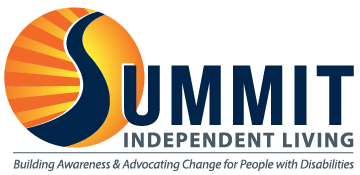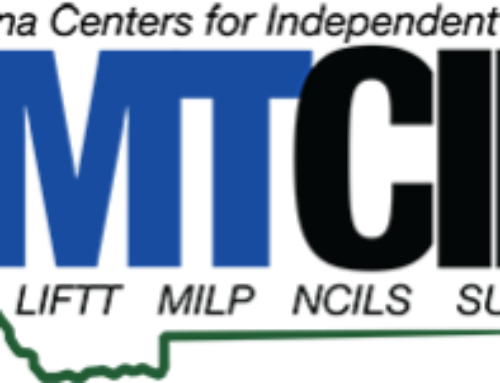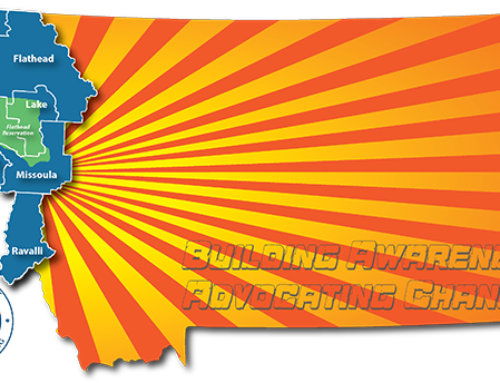In October ’09, Montana Independent Living Centers gathered in Billings to hold their Symposium. Seven task forces were identified to address the various barriers facing Montanans with disabilities. The Housing Task Force (HTF), having representation from all four Centers, decided work towards expanding affordable/accessible housing.
Promoting and advocating for Visitability became, and still is, the driving force behind the work of the task force. Visitability, a national movement, advocates that every home be built with 3 basic access features:
1) One zero-step entrance.
2) Doors with 32-36 inches of clear passage space.
3) One bathroom on the main floor with maneuver space for a wheelchair.
To counteract the cultural sentiment that accessible housing design is reserved for “specialized populations,” HTF joined the movement to argue that basic access benefits more people than just those with mobility difficulties; it benefits everyone. With help from the Montana Disability and Health program providing material and research assistance and the Montana Home Choice Coalition providing technical assistance, HTF has participated in resource and health fairs, conferences, state and local policy meetings and media opportunities to promote Visitability as a voluntary home building choice. It has also worked with state housing programs to establish Visitability as a mandatory requirement.
Using the momentum from achieving policy changes to require Visitability standards in several state housing programs, HTF has recently been meeting with State officials to explore ways of expanding affordable housing.
-
Visitability: Arguing for Common Sense
Whether you are moving furniture, bringing in wood or pushing two kids in a baby stroller, minimum home access features benefit everyone. They allow for a person to age in place and be prepared for the onset of a possible physical disability and the high home modification costs that will follow. Plus, it allows your friends and family to visit regardless of their physical condition. It makes sense.
Universal Design is a more recognized term than Visitability, but it encompasses more accessible features that go beyond basic access and can be argued to have more benefit for specialized populations, rather than the general population. It is better to begin by advocating for a need, rather than a want. The three minimum physical access features of Visitability can prevent an extended stay in a nursing home or homelessness. It is a need.
To advocate for these building practices, HTF has recommended that architects, builders, and homeowners voluntarily follow Visitability standards. HTF has also worked with policy makers to require these standards in various housing programs receiving state and federal grant funding. Here are some highlights of these actions within the last quarter.
Voluntary Actions
On 9/30, HTF was invited to present the benefits of Visitability at the American Institute of Architects fall conference in Great Falls. 50 architects attended the presentation and more visited the booth. The clear message given – architects offer everyone the opportunity to choose to build a home to reflect their desire to age in place and continue to invite family and friends to visit their home.
On 10/22, in Alaska, HTF presented at the Association for Programs of Rural Independent Living (APRIL) conference. The presentation centered on the need to advocate for Visitability and how to begin a Housing Task Force in other states. Visitability not being required in most or all housing programs exists in every state. 30 housing advocates attended.
On 10/31, Missoula KECI broadcasted a story during the evening news linking the difficulties for children with mobility issues to trick-or-treat during Halloween due to homes not being visitable.
Mandatory Actions
Over the past two years, HTF members have written numerous letters to the Board of Housing and Housing Division as well as have participated in public comment opportunities to recommend housing programs require Visitability standards. In addition, a database of Visitability personal testimonies is being collected and has been used to influence policy change.
On 10/17, the Montana Board of Housing adopted its 2012 Qualified Allocation Plan (QAP), including the visitable bathroom requirement. With that final inclusion, Visitability is now the minimum accessibility requirement for all housing to be funded through Montana’s Low Income Housing Tax Credit Program.
On 10/27, the State HOME Investment Partnership program and the Community Development Block Grant (CDBG) program introduced proposed changes to require Visitability design and other minimum accessibility features for all new home construction (HOME will also require these features for remodeled homes).
In November, the HOME Program accepted accepted the Visitability requirements, and Montana became the only state to require Visitability design in the QAP and HOME programs. CDBG was still accepting comments until 12/31.
On 11/10, Missoula Habitat for Humanity held an open house to showcase two new homes built with visitable design. All Missoula Habitat homes will be built this way.
Expanding Affordable Housing
Advocating for Visitability has given HTF a concrete concept to work towards. Task force members have taken ownership of continuing to expand basic access to all homes and look forward to sharing successes on monthly calls. In addition, it has given the opportunity to build a working relationship with decision makers to influence more complex housing issues.
The wait-list to acquire a Housing Choice Voucher (formerly known as ‘Section 8’) extends to 2-3 years. Without a voucher, to rent a 1 – bedroom modest housing unit, an individual living on SSI may have to pay 80 percent of his or her check towards rent. Even the vast majority of rental units that are specified to be for low income individuals are targeted to individuals earning 40-60 percent of Average Medium Income (AMI). In Montana, individuals living on SSI are calculated to be 20.6 percent of AMI.
On 9/15, Steve Gold, a national housing advocate, was invited to join a monthly call and present on using a percentage of HOME funds as Tenant Based Rental Assistance to bridge the gap of acquiring a Housing Choice Voucher.
To capitalize on the momentum from Mr. Gold’s presentation, HTF met with Jessica Rhoades – Health and Families Policy Advisor for Governor Schweitzer, department heads from Health and Human Services and program supervisors from the Housing Division to discuss the possibilities of using such a program. A second meeting will be held in January.
Ways to Help:
1. Join HTF: Call Darren Larson 728-1630 or email dlarson@summitilc.org
2. Fill out your personal Visitability testimony guide: http://www.surveygizmo.com/s/453201/visitability
3. Ask a friend, family member or neighbor to fill out their Visitability testimony guide
4. Like us on Facebook: http://www.facebook.com/MThousingtaskforce





Connect With Us